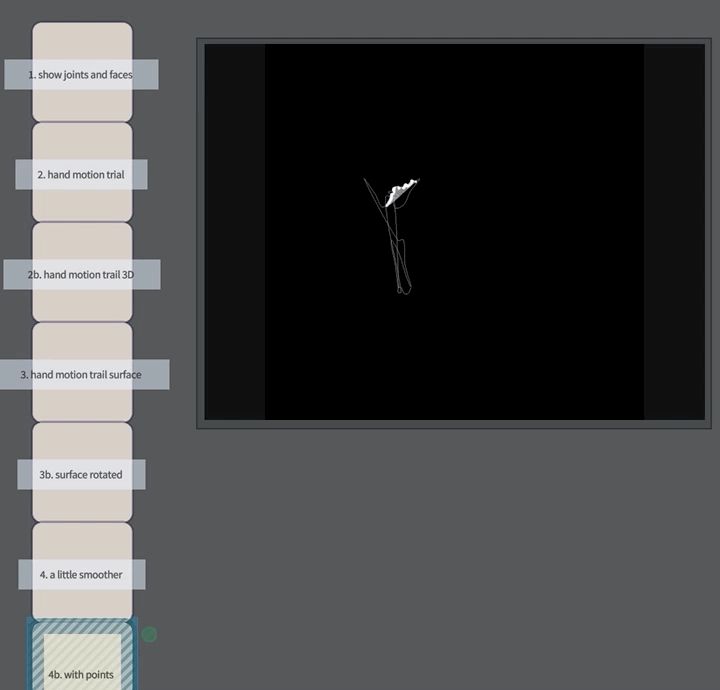
Drawing Computer Vision analyses in Field (Contours, Lines and OpenPose)
One of the analyses that the standard analysis package offers is contour extraction. For example:
python3 process.py --video /Users/marc/Downloads/IMG_2638.MOV --output_dir out2 --do_background --compute_contours --do_flow --do_lines --do_circles > contours.jsonWill produce a file called contours.json in the current directory.
Field can load these contour files and you can use them to form the basis of various abstractions. On this page we’ll build up one such ‘video / vector’ hybrid. It’s predicated on you reading introductory documentation for Field, the documentation for basic drawing and for “the Stage”. This page is given ‘cookbook style’ — lumps of code for you to tease apart, for the theory read the aformentioned pages first!
1. Checking to see that its loaded!
First, let’s just get something on the screen. Let’s run this code in a Field document with a Stage in it
// load a json file that has some contours in it
var q = loadJSONLines("/Users/marc/temp/pythonhead/contours.json")
// we're going to draw the 380th frame
// (the background subtractor doesn't kick in until after frame 120)
var FRAME = q.parse(380)
// clear everything we've drawn previously
_.stage.lines.clear()
// make a new line
var f = new FLine()
// for all of the contours in this frame
for(var n of FRAME.contours)
{
// start a new line at this position
f.moveTo(n[0][0], n[0][1])
for(var i=0;i<n.length;i++)
{
// and then extend it for every pair of points
// in the contour
f.lineTo(n[i][0], n[i][1])
}
}
// set the color to be a translucent white
f.color=vec(1,1,1,0.5)
// add a copy of the line to the stage
// we're going to scale it down by a factor of 0.15
// and scooch it down by 20 units
_.stage.lines.f = f * 0.15 + vec(0, 20)
// make sure we redraw the screen
_.stage.frame()Running this code yields an image on the Stage:

Which is a single frame of me waving at the camera.
2. Making it move
It’s easier to see that this came from some video when it moves, so let’s make it move:
// load a json file that has some contours in it
var q = loadJSONLines("/Users/marc/temp/pythonhead/contours.json")
while (_.stage.frame())
{
// starting at frame 120 until the end of the file
for(var frame=120;frame<q.lines.length;frame++)
{
// read that line
var FRAME = q.parse(frame)
// remove everything we’ve drawn so far
_.stage.lines.clear()
// make a new line
f = new FLine()
for(var n=0;n<FRAME.contours.length;n++)
{
var contour = FRAME.contours[n]
f.moveTo(contour[0][0], contour[0][1])
for(var i=1;i<contour.length;i++)
{
f.lineTo(contour[i][0], contour[i][1])
}
}
// same as before, a white line, in the right place
f.color=vec(1,1,1,0.5)
_.stage.lines.f = f * vec(100,70) + vec(0, 15)
// wait for 0.05 seconds between frames
_.stage.frame()
}
}Running this code (with alt / option - up):
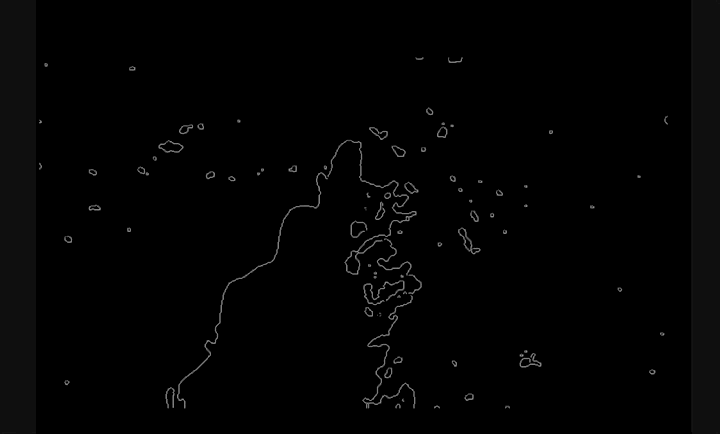
That seems like it’s working!
3. Now ‘break it’
Now that we have this working, we can step away from it towards abstraction:
// load a json file that has some contours in it
var q = loadJSONLines("/Users/marc/temp/pythonhead/contours.json")
// for-forever
while(true)
{
// for-every frame in the file (after frame 120)
for(var frame=120;frame<q.lines.length;frame++)
{
// parse the frame
var FRAME = q.parse(frame)
// *** and pull out two values from the analysis
var noisex = FRAME.mean_motion_x*4
var noisey = FRAME.mean_motion_y*4
// remove everything we've drawn so far
_.stage.lines.clear()
var f = new FLine()
for(var n of FRAME.contours)
{
for(var i=0;i<n.length;i+=4)
{
// add some random noise in the direction of motion
f.lineTo(n[i][0]+Math.random()*noisex,
n[i][1] +Math.random()*noisey)
}
}
// set the color of the line to be the average color of the scene
f.color=vec(FRAME.mean_blue/255,FRAME.mean_green/255,FRAME.mean_red/255,0.9)
f.pointed=true
f.pointSize=1
_.stage.lines.add(f * vec(100,70) + vec(0, 15))
_.stage.frame(0.05)
}
}Running this code, again, (with alt / option - up):
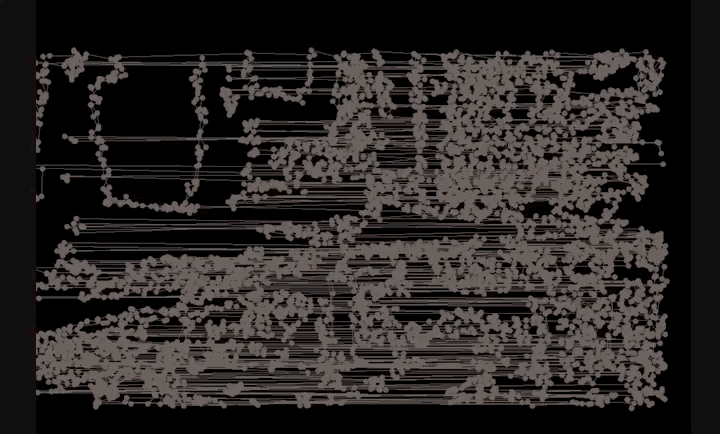
4. A little more video
The standard analysis package is also happy to emit a directory full of jpgs representing the original video and alternative versions of it. Let’s use those directories to texture the material we have here, allowing us to drag video around like paint.
var q = loadJSONLines("/Users/marc/temp/pythonhead/contours.json")
// make a video textured layer from the directory
// given by the processor
var ll = _.stage.withImageSequence("/Users/marc/temp/pythonhead/out2/input/")
// with a little bit of motion blur
_.stage.background.a = 0.3
while(true)
{
for(var frame=120;frame<q.lines.length;frame++)
{
// animate the video texture
ll.frame=frame
// draw the lines as before
var FRAME = q.parse(frame)
var noisex = FRAME.mean_motion_x*1.
var noisey = FRAME.mean_motion_y*1.
ll.lines.clear()
var f = new FLine()
for(var n of FRAME.contours)
{
for(var i=0;i<n.length;i+=4)
{
f.smoothTo(n[i][0]*0.1, n[i][1]*0.18)
}
}
// texture the line
ll.bakeTexture(f)
f.pointed=true
// more grit
f.pointSize=FRAME.mean_motion_px/100-3
// make it a little more red
f.color=vec(1.3,0.5,0.3,1)
// but the points tilt blue
f.pointColor = vec(0.2,0.6,1.3,0.1)
f = f.byTransforming(x => vec(x.x+Math.random()*noisex, x.y+Math.random()*noisey,0))
// shrink it to have the correct size
ll.lines.add(f * vec(100,70) + vec(0, 15))
_.stage.frame(0.05)
}
}Gives this abstraction:
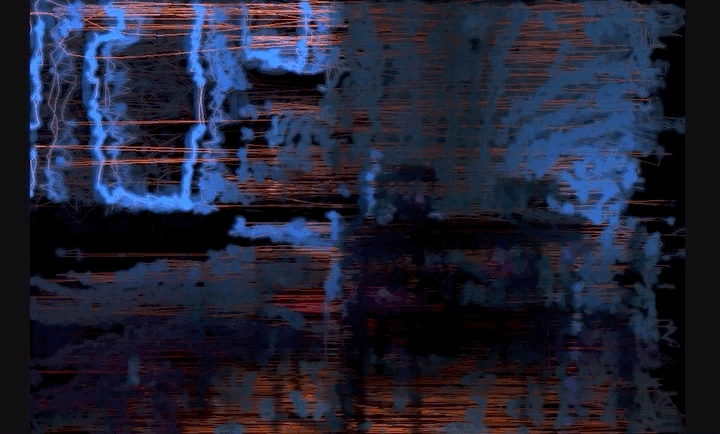
5. Edges
We can also use other aspects of the analysis. Here’s some code that pulls out information from the line detector.
var q = loadJSONLines("/Users/marc/temp/pythonhead/contours.json")
// make a video textured layer from the directory
// given by the processor
var ll = _.stage.withImageSequence("/Users/marc/temp/pythonhead/out2/input/")
// with a little bit of motion blur
_.stage.background.a = 0.3
while(true)
{
for(var frame=120;frame<q.lines.length;frame++)
{
// animate the video texture
ll.frame=frame
// draw the lines as before
var FRAME = q.parse(frame)
var noisex = FRAME.mean_motion_x*0.1
var noisey = FRAME.mean_motion_y*0.1
ll.lines.clear()
var f = new FLine()
for(var n of FRAME.lines)
{
// a line has four numbers - the x,y of the start and the x,y of the end
f.moveTo(n[0][0]*0.1, n[0][1]*0.18)
f.lineTo(n[1][0]*0.1, n[1][1]*0.18)
}
// texture the line
ll.bakeTexture(f)
f.pointed=true
// map motion to line thicknes
f.fastThicken=FRAME.mean_motion_x*FRAME.mean_motion_x/4000+1
// more grit
f.pointSize=FRAME.mean_motion_px/300
// make it a little more red
f.color=vec(1.0,0.5,0.9,1)
// but the points tilt blue
f.pointColor = vec(1.8,1.2,1.0,0.1)
f = f.byTransforming(x => vec(x.x+Math.random()*noisex, x.y+Math.random()*noisey,0))
// shrink it to have the correct size
ll.lines.add(f * vec(100,70) + vec(0, 15))
_.stage.frame(0.05)
}
}Yields:
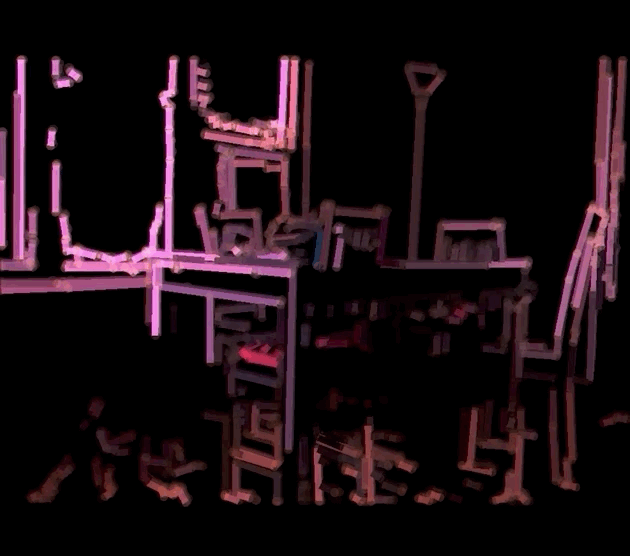
OpenPose
OpenPose produces .json files which include skeleton points as well as landmarks for faces and hands. Recent versions of Field (22c and above) can open these directories full of .json files:
// import OpenPose reader
var OpenPose = Java.type("trace.mocap.OpenPose")
// open a directory of open pose files
// we need to pass in the resolution of the original
// movie so everything gets scaled correctly
var op = new OpenPose("/Users/marc/Documents/XC/lecture2/anastasia_1/output", 1920, 1080)
// we'll draw every frame
for(var frame of op.frames)
{
_.stage.lines.clear()
// we'll draw ever person
for(var person of frame.people)
{
var f = new FLine()
// we'll doodle through all of the points
for(var point of person.points)
{
// we'll only plot points that have non-zero
// 'confidence' which is stored in 'z'
if (point.z>0)
f.smoothTo(point.x, point.y)
}
// line in white
f.color=vec(1,1,1,1)
// added to the list of lines to draw
_.stage.lines.add(f)
}
// similarly, we'll draw the faces as well
for(var face of frame.faces)
{
var f = new FLine()
for(var point of face.points)
{
if (point.z>0)
f.smoothTo(point.x, point.y)
}
f.color=vec(1,1,1,1)
_.stage.lines.add(f)
}
// wait 1/10 of a second before continuing on
_.stage.frame(0.1)
}Yields:
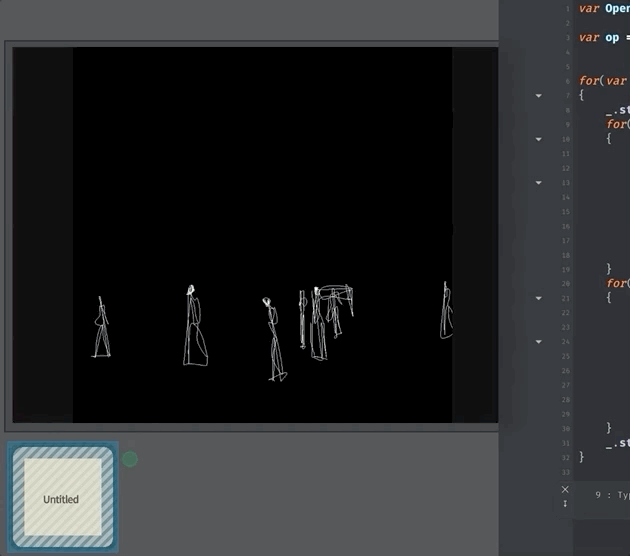
OpenPose — 7 lessons
Let’s build up the code above slowly and then move into 3D. You can see the start of this here:
1 — Showing a point
var OpenPose = Java.type("trace.mocap.OpenPose")
var op = new OpenPose("/Users/marc/Documents/theron_playground/marc_1/output", 1920, 1920)
for(var frame of op.frames)
{
_.stage.lines.clear()
for(var person of frame.people)
{
var f = new FLine()
for(var point of person.points)
{
if (point.z>0)
f.lineTo(point.x, point.y)
}
f.color=vec(1,1,1,1)
_.stage.lines.add(f)
// draw point 4 (right hand)
var p = person.points[4]
if (p.z>0)
{
var f = new FLine()
f.moveTo(p.x, p.y)
f.color=vec(1,1,1,1)
f.pointed=true
f.pointSize=3
_.stage.lines.add(f)
}
}
for(var face of frame.faces)
{
var f = new FLine()
for(var point of face.points)
{
if (point.z>0)
f.smoothTo(point.x, point.y)
}
f.color=vec(1,1,1,1)
_.stage.lines.add(f)
}
_.stage.frame(0.05)
}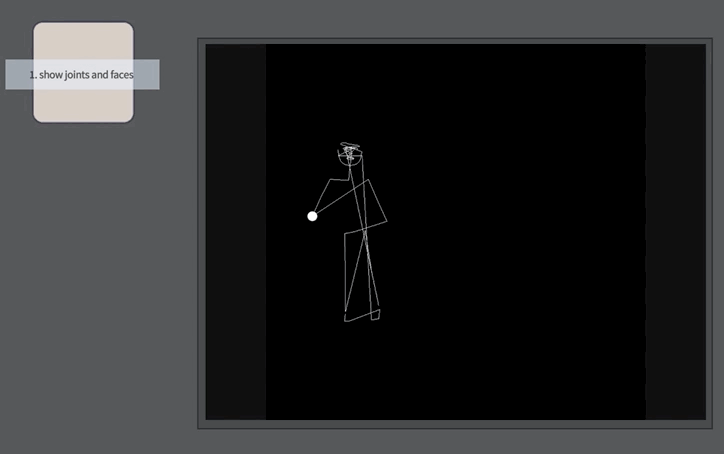
2 — A motion trail
var OpenPose = Java.type("trace.mocap.OpenPose")
var op = new OpenPose("/Users/marc/Documents/theron_playground/marc_1/output", 1920, 1920)
var f = new FLine()
f.color=vec(1,1,1,1)
_.stage.lines.add(f)
for(var frame of op.frames)
{
for(var person of frame.people)
{
// draw point 4 (right hand)
var p = person.points[4]
if (p.z>0)
{
f.lineTo(p.x, p.y)
}
}
_.stage.frame(0.05)
}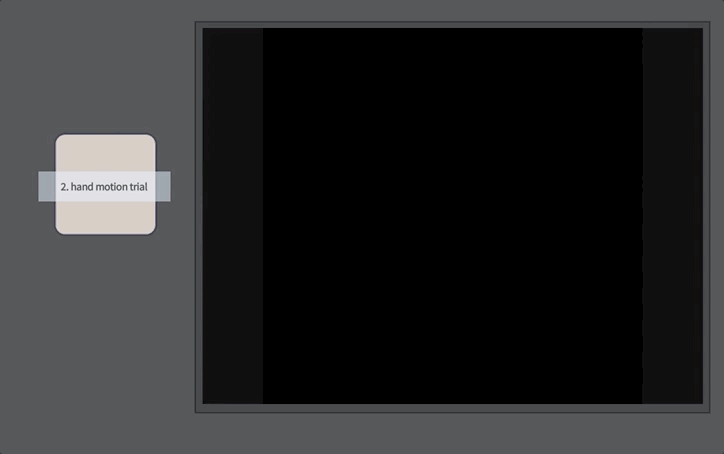
2b — A motion trail, but in 3D
var OpenPose = Java.type("trace.mocap.OpenPose")
var op = new OpenPose("/Users/marc/Documents/theron_playground/marc_1/output", 1920, 1920)
var f = new FLine()
f.color=vec(1,1,1,1)
var layer = _.stage.withName("asdf")
layer.is3D = true
layer.makeKeyboardCamera()
layer.vrDefaults()
layer.camera.position = vec(0.1, 0.05, -0.2)
layer.camera.target = vec(0, 0.05, 0)
_.stage.lines.clear()
layer.lines.clear()
layer.lines.f = f
for(var frame of op.frames)
{
for(var person of frame.people)
{
// draw point 4 (right hand)
var p = person.points[4]
if (p.z>0)
{
f.lineTo(p.x/1000, p.y/1000)
}
f = f + vec(0, 0, 0.01)
layer.lines.f = f
for(var person of frame.people)
{
var b = new FLine()
for(var point of person.points)
{
if (point.z>0)
b.smoothTo(point.x/1000, point.y/1000)
}
b.color=vec(1,1,1,0.3)
layer.lines.body = b
}
}
_.stage.frame(0.05)
}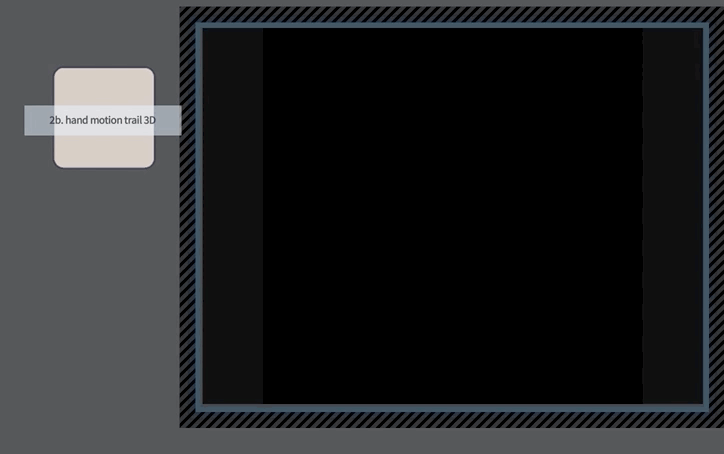
3 — A motion ‘surface’
We can turn that into a surface by adding f.filled=true, but for completeness:
var OpenPose = Java.type("trace.mocap.OpenPose")
var op = new OpenPose("/Users/marc/Documents/theron_playground/marc_1/output", 1920, 1920)
var f = new FLine()
f.color=vec(1,1,1,1)
var layer = _.stage.withName("asdf")
layer.is3D = true
layer.makeKeyboardCamera()
layer.vrDefaults()
layer.camera.position = vec(0.1, 0.05, -0.2)
layer.camera.target = vec(0, 0.05, 0)
f.filled=true
_.stage.lines.clear()
layer.lines.clear()
layer.lines.f = f
for(var frame of op.frames)
{
for(var person of frame.people)
{
// draw point 4 (right hand)
var p = person.points[4]
if (p.z>0)
{
f.lineTo(p.x/1000, p.y/1000)
}
f = f + vec(0, 0, 0.001)
layer.lines.f = f
for(var person of frame.people)
{
var b = new FLine()
for(var point of person.points)
{
if (point.z>0)
b.smoothTo(point.x/1000, point.y/1000)
}
b.color=vec(1,1,1,0.3)
layer.lines.body = b
}
}
_.stage.frame(0.05)
}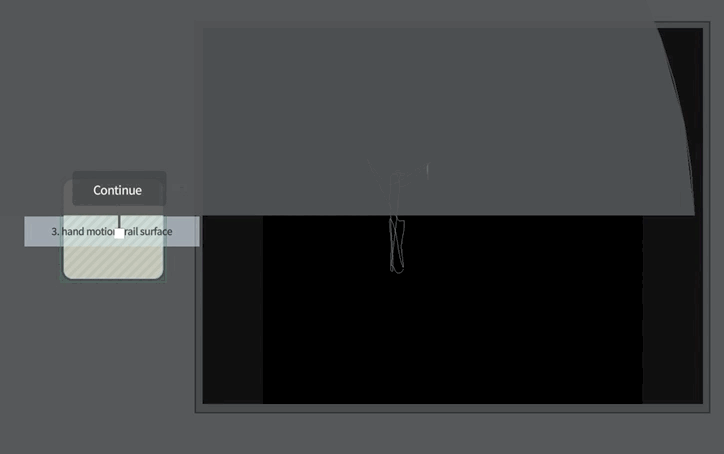
3b — more distortion (rotating as well as translating)
var OpenPose = Java.type("trace.mocap.OpenPose")
var op = new OpenPose("/Users/marc/Documents/theron_playground/marc_1/output", 1920, 1920)
var f = new FLine()
f.color=vec(1,1,1,0.3)
var layer = _.stage.withName("asdf")
layer.is3D = true
layer.makeKeyboardCamera()
layer.vrDefaults()
layer.camera.position = vec(0.1, 0.05, -0.2)
layer.camera.target = vec(0, 0.05, 0)
f.filled=true
_.stage.lines.clear()
layer.lines.clear()
layer.lines.f = f
for(var frame of op.frames)
{
for(var person of frame.people)
{
// draw point 4 (right hand)
var p = person.points[4]
if (p.z>0)
{
f.lineTo(p.x/1000, p.y/1000)
}
f = f + vec(0, 0, 0.001)
f = (f - vec(p.x/1000, p.y/1000)) * rotate3(1, vec(0,0.5, 0.5)) + vec(p.x/1000, p.y/1000)
layer.lines.f = f
for(var person of frame.people)
{
var b = new FLine()
for(var point of person.points)
{
if (point.z>0)
b.smoothTo(point.x/1000, point.y/1000)
}
b.color=vec(1,1,1,0.3)
layer.lines.body = b
}
}
_.stage.frame(0.05)
}4 — smoothing the motion
var OpenPose = Java.type("trace.mocap.OpenPose")
var op = new OpenPose("/Users/marc/Documents/theron_playground/marc_1/output", 1920, 1920)
var f = new FLine()
f.color=vec(1,1,1,0.3)
var layer = _.stage.withName("asdf")
layer.is3D = true
layer.makeKeyboardCamera()
layer.vrDefaults()
layer.camera.position = vec(0.1, 0.05, -0.2)
layer.camera.target = vec(0, 0.05, 0)
f.filled=true
_.stage.lines.clear()
layer.lines.clear()
layer.lines.f = f
var previous = null
var alpha = 0.9
for(var frame of op.frames)
{
for(var person of frame.people)
{
// draw point 4 (right hand)
var p = person.points[4]
var at = vec(p.x/1000, p.y/1000)
if (p.z>0)
{
if (previous==null)
previous = at
else
at = at * (1-alpha) + (alpha) * previous
f.lineTo(at)
}
amount = Math.min(1.0, 0.1+ previous.distance(at)*1000)
f = f + vec(0, 0, 0.001*amount)
f = (f - at) * rotate3(amount, vec(0,0.5, 0.5)) + at
layer.lines.f = f
for(var person of frame.people)
{
var b = new FLine()
for(var point of person.points)
{
if (point.z>0)
b.smoothTo(point.x/1000, point.y/1000)
}
b.color=vec(1,1,1,0.3)
layer.lines.body = b
}
previous = at
}
_.stage.frame(0.05)
}5 — with points again
var OpenPose = Java.type("trace.mocap.OpenPose")
var op = new OpenPose("/Users/marc/Documents/theron_playground/marc_1/output", 1920, 1920)
var f = new FLine()
f.color=vec(1,1,1,0.3)
var layer = _.stage.withName("asdf")
layer.is3D = true
layer.makeKeyboardCamera()
layer.vrDefaults()
layer.camera.position = vec(0.1, 0.05, -0.2)
layer.camera.target = vec(0, 0.05, 0)
layer.bindTriangleShader(_)
f.filled=true
_.stage.lines.clear()
layer.lines.clear()
layer.lines.f = f
var previous = null
var alpha = 0.5
for(var frame of op.frames)
{
for(var person of frame.people)
{
// draw point 4 (right hand)
var p = person.points[4]
var at = vec(p.x/1000, p.y/1000)
if (p.z>0)
{
if (previous==null)
previous = at
else
at = at * (1-alpha) + (alpha) * previous
f.smoothTo(at.noise(0.001))
}
amount = Math.min(1.0, 0.01+ previous.distance(at)*1000)
f = f + vec(0, 0, 0.004*amount)
f = (f - at) * rotate3(amount*0.1, vec(0,0.5, 0.5)) + at
f.pointed=true
f.last().pointSize=amount*amount*amount*1
f.pointSize=1
layer.lines.f = f
for(var person of frame.people)
{
var b = new FLine()
for(var point of person.points)
{
if (point.z>0)
b.smoothTo(point.x/1000, point.y/1000)
}
b.color=vec(1,1,1,0.3)
layer.lines.body = b
}
previous = at
}
_.stage.frame(0.05)
}